In late August 2005, Hurricane Katrina entered the Gulf of Mexico, quickly intensifying to an extremely dangerous Category 5 hurricane. On August 29, 2005, it made landfall as a powerful Category 3 storm which caused major devastation in the Greater New Orleans area. Beyond the rain and wind, the failure of the federally built protection system devasted the city — when the levees broke, the city built below sea level filled with water.
Katrina almost destroyed the city of New Orleans. For one law firm founded and headquartered in New Orleans, the once-in-a-generation storm threatened the firm’s very existence. Yet, the recovery efforts proved the resiliency of the Crescent City, and for Galloway Johnson Tompkins Burr & Smith, the storm proved the firm’s mettle and character. From five offices pre-Katrina, Galloway has grown to 13 offices across the Gulf South and Midwest.
In honor of Katrina’s 20th anniversary, six Galloway attorneys were asked to reflect on their experience through this pivotal point for themselves and for the firm. As the storm approached, none of them anticipated what would happen in those days and weeks. Two decades later, they look back on what happened, the lessons learned, and the growth experienced personally and professionally.
Galloway Attorneys Pre-Katrina
In July 2005, Galloway had five thriving office locations: Houston, Texas; Pensacola, Florida; Lafayette, Mandeville, and New Orleans, Louisiana. “It seemed to be a good time for the firm,” said Jason Waguespack. “As I recall, things were humming along.” Founding attorney Tim Burr was the firm’s Managing Director, based in Pensacola.
Jason was serving as Managing Director of Galloway’s New Orleans office, the firm’s largest office at the time. That summer, he and his team had wrapped up a complicated cargo case originally tried in Houston before it was heard by the Fifth Circuit Court of Appeals. The decision came down in the summer of 2005, right before Hurricane Katrina. “Like a lot of decisions, I won some of it and I lost some of it, but it was a big deal because the case had been a big case,” commented Jason.
On Jason’s team was a young Associate named Frederick “Billy” Swaim, who joined Galloway in July 2003 after graduating from law school earlier that spring. “In those first couple of years, as a young lawyer, we were pretty hectic,” Billy remembers. “We were here every weekend and it taught me the value of hard work.” In his personal life, Billy and his wife Tara were raising their one-year old daughter.
Richard Duplantier was an established Director with the firm, having joined Galloway in 1990. After joining the firm in 2002, Stephen Moore was on Rick’s team and had just made Director in 2005. His wife was expecting their second son and was about eight months pregnant before Katrina.
Doris Bobadilla had been with Galloway for about seven years, having made Director in 2004. “I was really coming up in my career, it was doing well, and I just built a beautiful new house in Arabi,” Doris recalls. Her extended family was all within a five mile radius in St. Bernard Parish.
Mark “Tiger” Pharr had been with Galloway for about ten years, having joined Galloway’s Houston office in 1994 before opening the Lafayette office in 2000. “The Lafayette office took a while to get off the ground,” starting with a small shared office before expanding. “Right about the time of Katrina is when we started getting more traction with clients, and we had signed a lease for a space on Ambassador Caffrey.” It was this office space that would prove providential for Galloway’s recovery after Hurricane Katrina.
The Storm Approaches
Many doubted Katrina would strike New Orleans. After years of near-misses, guards were down, and repeated false alarms left people wary of evacuating. Trial prep continued for upcoming cases.
For others, late summer meant social events and time away from the office. Early projections saw the storm heading towards Florida, but by the weekend, the path dramatically shifted to a direct hit on New Orleans.
Stephen knew it was on its way to the Panhandle. “I had depositions set for Monday in Thibodeaux. I called the lawyer, and I was talking to him about the arrangements for the deposition, and he said, yeah, we might not have them because there’s this storm coming.” The opposing counsel told Stephen to look at the weather again and see the track. “Back then, no one looked at spaghetti plots or any of that. I looked at the news and sure enough, the cone of danger was right on New Orleans.”
With weekend plans to paint the nursery, Stephen didn’t think anything of it and didn’t mention it to his wife. “On Saturday morning, I went to Home Depot and bought a can of paint, and I came home and the neighbors had called her. Our immediate reaction was, I’m 8 months pregnant and I am not sitting in the car for 10 hours for a false alarm.” After another phone call, Stephen’s wife said they should evacuate. “There’s no circumstance in which my pregnant wife and I were going to get stuck in the attic, so when she said let’s go, I said let’s go.”
Tiger remembers the calm before the storm vividly. “Two days before it got to New Orleans, my wife, Allyson, and I were in New Orleans for an executive get-together that happens annually.” With a dinner catered by Chef John Folse, spirits were high. “When it started moving its track and Jim Cantore is saying I’m going to New Orleans, everybody started scrambling.” The dinner was cut short, and Tiger and his wife left New Orleans early Saturday morning with many others evacuating the city.
“There’s no circumstance in which my pregnant wife and I were going to get stuck in the attic, so when she said let’s go, I said let’s go.” — Stephen Moore
“When it started moving its track and Jim Cantore is saying I’m going to New Orleans, everybody started scrambling.” — Mark “Tiger” Pharr
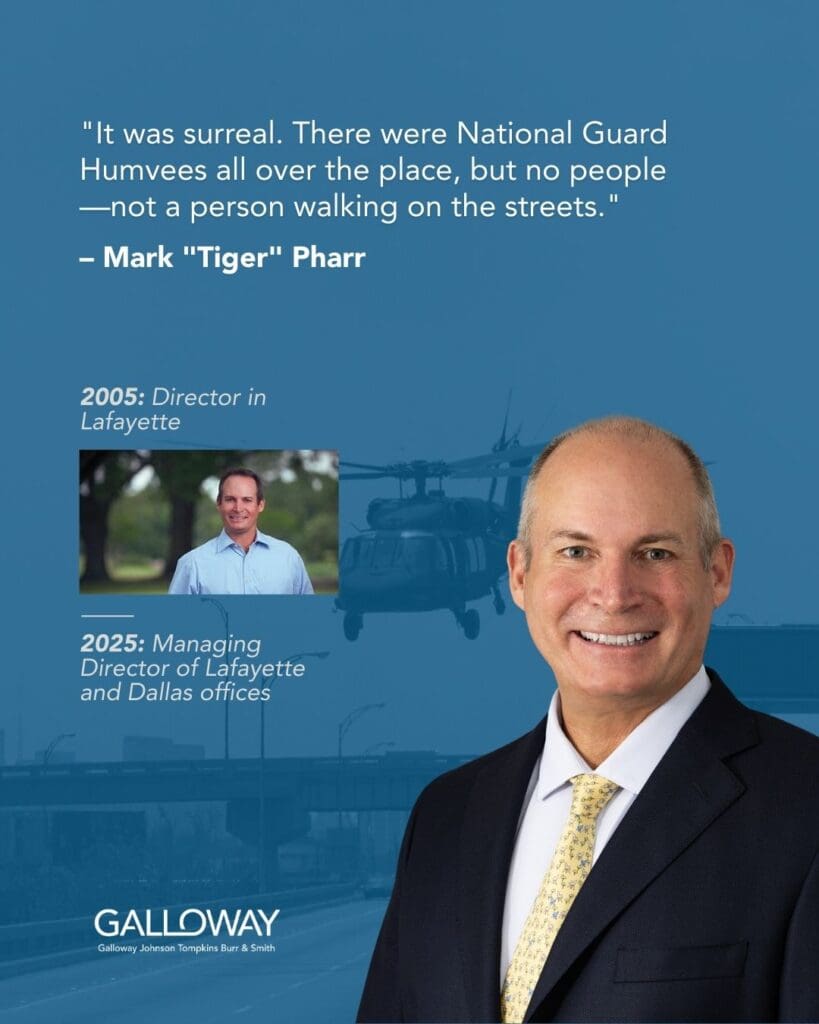
“As we’re watching the storm barreling into the line, I remember my dad saying, what the hell are we doing here?” — Frederick “Billy” Swaim
Evacuation and the Levees Break
Billy’s wife and daughter evacuated to Tyler, Texas, to stay with family. “We packed up what we needed to pack up at the office, and I grabbed a bunch of stuff, including my time sheets which was a good move. I was going to stay because my dad didn’t want to leave.” When he was on his way to his parents’ house, Billy stopped to talk to an older gentleman who was arguing with his son about leaving; unfortunately, the son couldn’t convince him and the gentleman died in the storm.
“As we’re watching the storm barreling into the line, I remember my dad saying, what the hell are we doing here?” Billy and his dad quickly packed, left, and encountered bumper to bumper traffic late Sunday. “I remember being really paranoid about not getting anywhere, and we just kept putting along when we started getting hit with some of the first bands because we decided to leave way too late.” They eventually made it Lafayette before continuing to Tyler – a 20 hour drive.
In the initial hours after landfall, there was uncertainty about the true damage caused by the storm. Communication was disrupted and little information was coming out of the city. Jason was in Birmingham, Alabama, watching coverage as the storm came in. “I remember thinking as we watched it, it’s not as bad as we thought it was going to be, and feeling very relieved about it. And it was only in the afternoon that they started reporting that the levees broke, and we couldn’t get home.”
At the time, the firm’s technology was far less advanced than it is today. Hard files and paper time sheets were still standard, and all firm data ran through servers housed in the New Orleans office. Just days after the storm, thanks to local contacts, Galloway attorneys gained access to the city to recover essential equipment and move it to Lafayette. Tiger recalled, “It was surreal. There were National Guard Humvees all over the place, but no people—not a person walking on the streets. We pulled to the back of One Shell Square, and the guard led us up to the 40th floor. We put all of the servers on carts and loaded boxes and boxes of red wells for certain cases.” From John Galloway’s office, the view was haunting: “You could look down Poydras toward the Superdome and see the water, and you could see all the people around the Superdome. It was a surreal experience.”
Lafayette Welcomes New Orleans
By midweek, plans were set in motion. Jason remembers, “At that point, no one’s cell phones were working. When we got to my sister’s house in Denham Springs, I was able to talk to the other partners. There was, as you can imagine, a lot of stress. And Tiger said, come to Lafayette.”
A lease for the new office in Lafayette was signed, but the space was not ready. Thankfully, the landlord was accommodating. “We put 2 or 3 folding tables in each exterior office, and we had eight or ten lawyers from the New Orleans office housed in our new space working from there,” Tiger recalls. “It was kind of like camp – we’d go to lunch and everybody got kind of close, given the circumstances, and just made do.” Rick added, “Those experiences stick out because we were all working in close quarters together to make sure that we stayed engaged.”
With her house in Arabi underwater, Doris quickly found a house to rent in Lafayette and reported to Galloway’s office within days. Nine family members, from two grandmothers to two babies, all shared the unfurnished home with only a few belongings. She added, “The good thing even back then was that we had other offices to go to. There’s always a sense of fear that there might be layoffs, and so with a one-year-old, I didn’t want that to be me.” Doris remembered, “I remember buying myself an office chair, something from Office Depot. I was set that if I was going to work on one of these (folding tables), I had to have a nice chair. It was fine and you made do, and I just felt special enough to have a good place to sit.” To this day, the Galloway office in Lafayette and the community holds a warm spot in her heart. “The folks were so nice and helpful, the people in the area of Lafayette were super welcoming.”
Billy remembered, “I was only in Tyler for a couple of days. I was trying to call Jason Waguespack and others in the firm to see if I still had a job and what was going to happen with New Orleans, what we were supposed to do.” Jason directed him to Lafayette. On the drive out, however, life quickly shifted from professional concerns to personal ones. “As I was leaving Tyler, my wife was having some physical pains. I’m supposed to go to Lafayette, but we go to the hospital in Tyler to find out what’s wrong with her. She’s pregnant.”
Despite the “invasion” of New Orleans attorneys into Lafayette and despite losing so much, the resiliency of Galloway attorneys shone through. Jason said, “Everybody was stressed out to the max, and Billy was living in a hotel room with his father who was in a wheelchair, his mother, his wife, his small daughter. He knew his house was destroyed. I never once saw that guy in a cranky mood. He was always reliable.”
Will New Orleans Reopen?
Though the New Orleans attorneys were making the best of the situation, there were growing concerns that it may not be tenable to reopen the New Orleans office through this trying time. Would New Orleans as a city ever come back, and where would the business flow from, especially as New Orleans was the biggest and most central office?
Jason remembers, “The city was battered, but I remember coming back and feeling like, okay, we’re going to come back when I saw it for myself. There was a real anxiety about how long we were going to be able to support team members, because New Orleans was our largest office and it was where all the checks were sent.” With limited business, “it was an existential threat to the firm. I did my upmost to project confidence that everything was going to be okay, but I wasn’t confident that it was going to be okay. I tried very hard to show optimism while at the same time realizing that almost everybody in the New Orleans office lost something, and some people lost everything.”
Galloway attorneys pressed their landlord, and the New Orleans office reopened in mid-October 2005. Rick said, “There was no question in mind that we had to reopen the New Orleans office. It was vital to me. In no uncertain terms, the question on everybody’s mind for the first couple of months was, will we survive this? And how do we survive this?” For Rick, having a presence in downtown New Orleans validated that Galloway has grown into a premier, significant regional law firm.
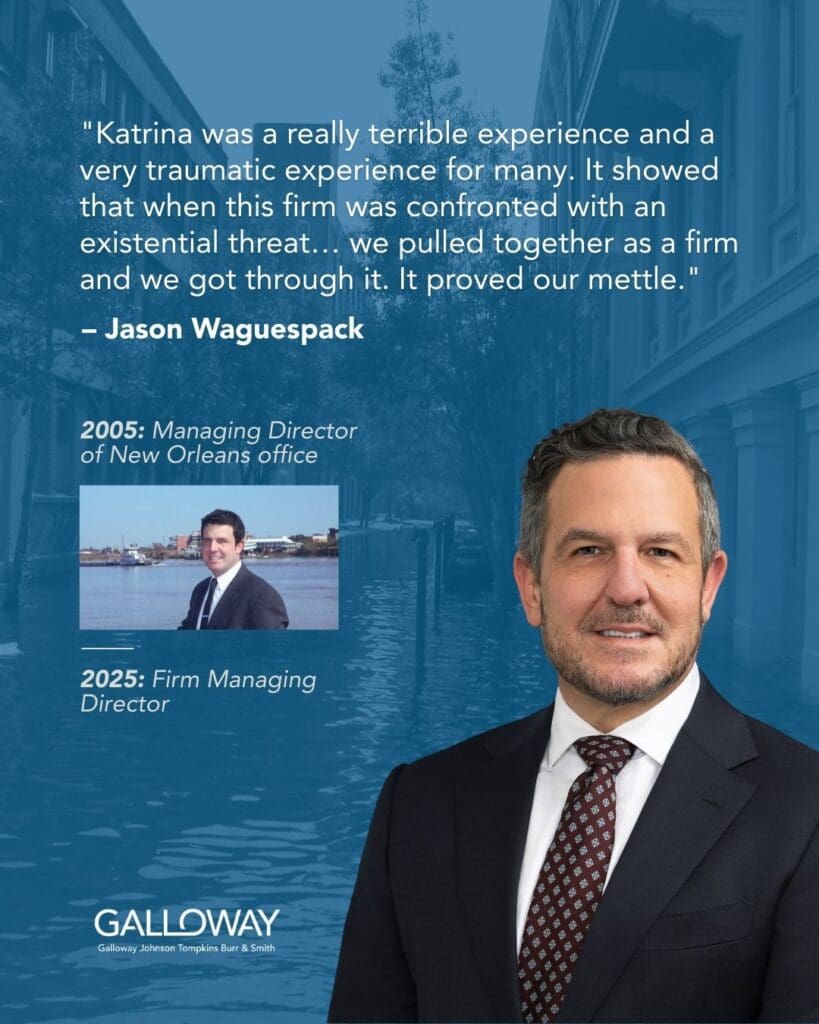
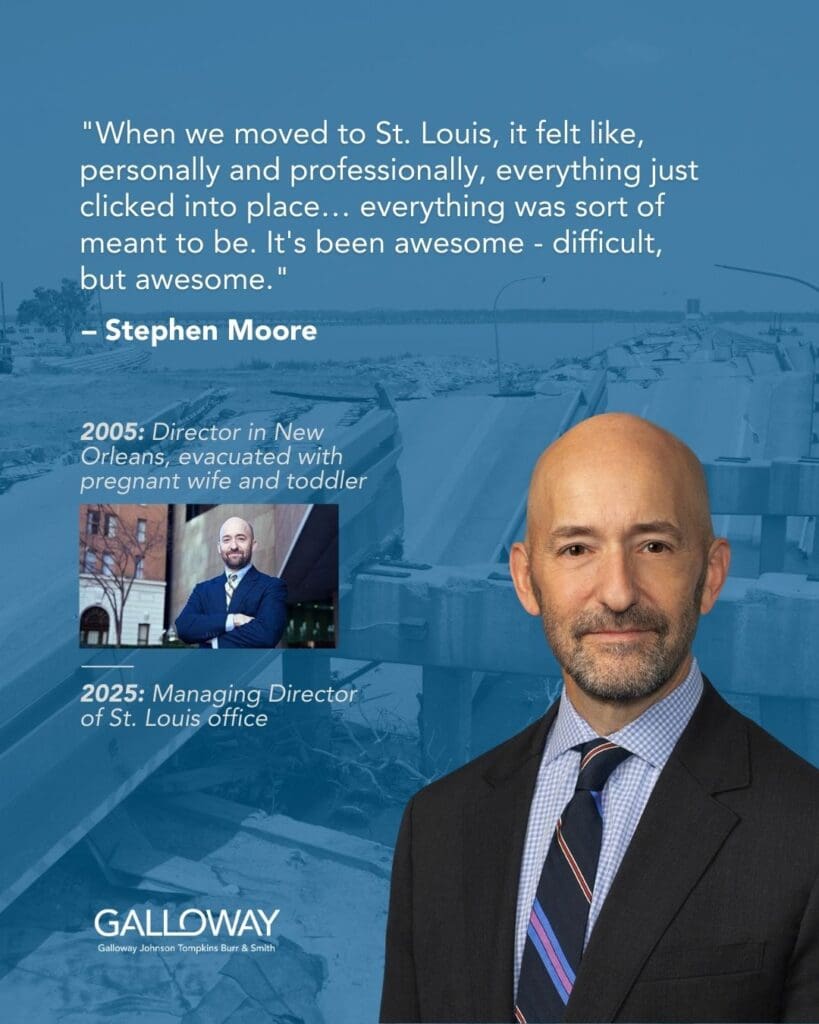
Galloway Expands to St. Louis
Not everyone came back to New Orleans post-Katrina. Stephen Moore was one of them. After evacuating, his wife had to find someplace more permanent to have the baby, and they settled with family in Arkansas. Ten days after the baby was born, they went to Connecticut where her family lived. “I stayed behind in Pensacola, and in the interim we decided we have to find someplace else to live. I grew up in southwest Missouri, and when you kind of lose everything that you have, you start thinking, it’d be helpful if I were near some family.” With St. Louis being like New Orleans, it seemed familiar to the Moore family.
Taking the first job he could find in St. Louis, Stephen eventually realized that he missed working for Galloway. “After 3 months in, I emailed Rick and said, just joking really but sort of desperate, what do you think about a St. Louis office?” Within minutes, Rick emailed back with a positive response.
Rick Duplantier added, “I said, well, you know, you’re on the Mississippi, so you’re not technically in the Gulf South, but we can pitch it as another place to evacuate to, because who knows what offices could be impacted by the next storm. People were still a little gun shy about the whole idea of expansion. Are we thinning ourselves out too much? There was definitely some trepidation about it.”
After conversations began in March 2006, Galloway officially opened the St. Louis office in July 2006. Stephen reflected, “It was an incredible gift to me that they were willing to do that, because I’ve always loved the firm. Galloway is really a different place than any place else I’ve ever worked, and I was really happy to be reunited with the firm.” Rick added, “I did think it was good for the firm because Stephen grew up in our culture, and that helps. He knows that we commit to people, and that good employees are more important than anything.”
Lasting Lessons for Attorneys
Doris Bobadilla didn’t know then how much her life would change. “It was such an altering event. With change can sometimes breed opportunity and energy. I don’t know what my life would have been without Katrina, but I do know what my life is with it. It fortified my internal belief that if you remain positive in something, you will succeed. We didn’t have a home, we didn’t have clothes, and yet we found a way to make do.”
Professionally, having an additional license in Mississippi kept Doris’ career going. “The Mississippi work didn’t slow down in Jackson or northern Mississippi, so I would continue to work because I had work to do in that area before we had an office in Gulfport. It kept me going. In my eyes, it’s what made Mississippi and more than one license so important.” Today, she has an active bar license in five Gulf Coast states – Texas, Louisiana, Mississippi, Alabama, and Florida. “This firm’s footprint has always encouraged me to seek the opportunity that the firm provides. More than one license does shape a career for the better.”
As a member of the firm’s technology committee, Mark “Tiger” Pharr took away major lessons in technology. “As a firm, it was the trigger for us to go into the cloud with our servers. That was just on the cutting edge, we had discussions about it. It was an impetus to put everything in a secure cloud.” Galloway was an early adopter of cloud technology in the mid 2000s and continues to implement new and emerging technologies.
From gutting his house personally to raising a young family, Frederick “Billy” Swaim looks back on the formative time as one of constant juggling between personal upheavals and professional demands. “You can’t control everything, and there are things that you can worry about and things that you can’t fix.” He also learned valuable lessons as a young lawyer. “If you’re not developing and learning in your first few years, you’re probably not doing it right. It was a time when there was a lot going on physically and mentally as a young lawyer. How can life change any more? It was pretty unbelievable.”
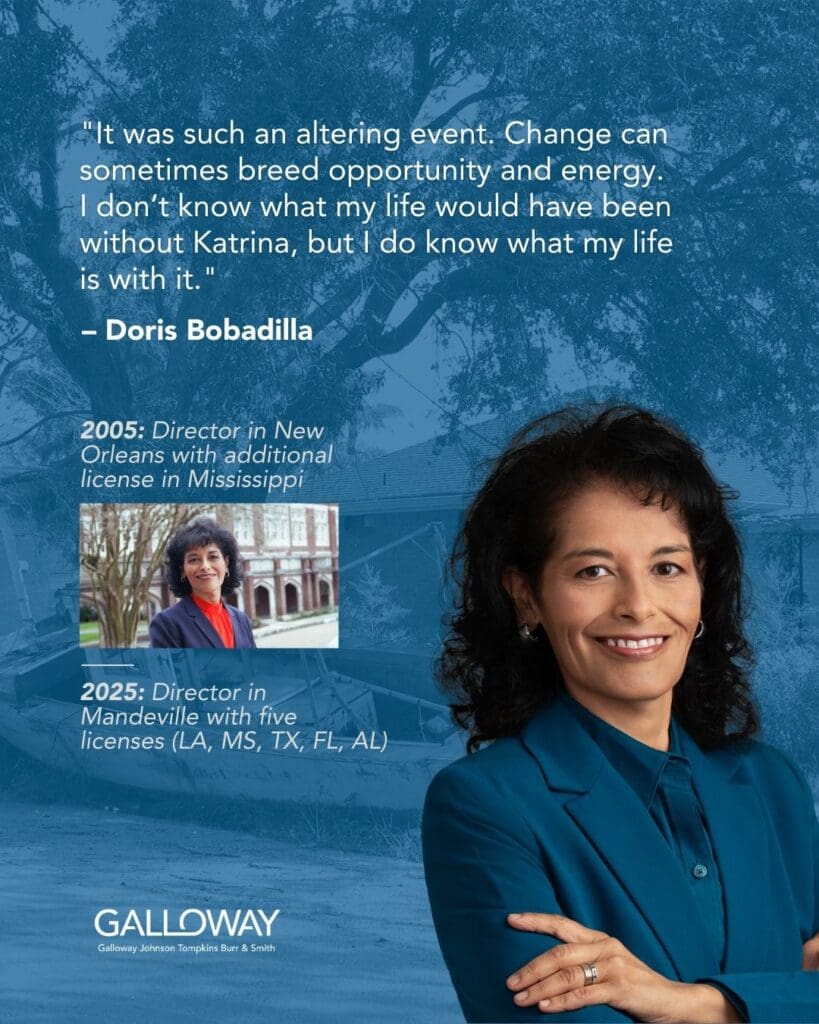
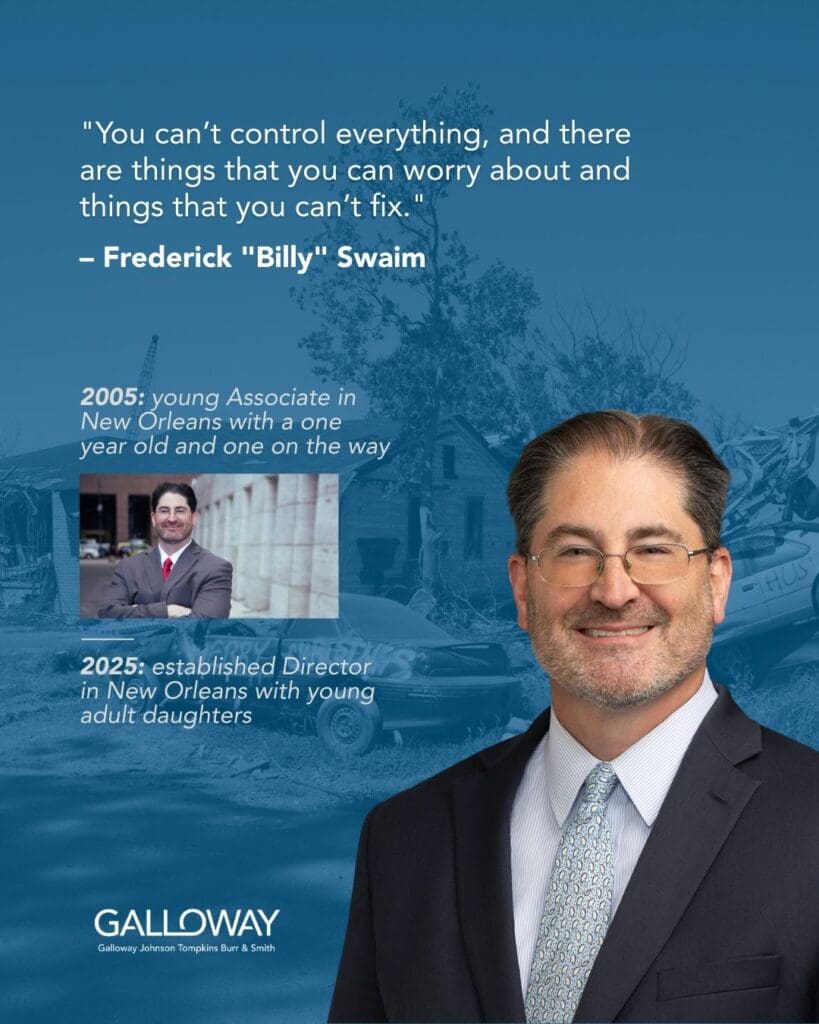
What Katrina Meant Personally and Professionally for Galloway
As Galloway approaches its fortieth year as a firm, the Katrina experience is one chapter in an expansive history.
For Stephen Moore, Katrina was a major turning point for him personally and professionally. “When we moved to St. Louis, it felt like, personally and professionally, everything just clicked into place. If you’ve been driving in the wrong gear for a long time, and it just shifts, everything is smooth. Everything was sort of meant to be. I don’t know where I would be if I hadn’t made these moves. Support from New Orleans and Houston has been huge. It’s been awesome. Difficult, but awesome.” Today, as the St. Louis office nears its own twentieth anniversary, Stephen and the attorneys there continue to work a full docket while remaining active in the community.
Rick Duplantier saw the opportunity to rebuild stronger. “Not only are we going to survive this tragedy, but we’re going to see it as an opportunity to engage in our development. There was value of having multiple places to evacuate to, and those opportunities were beneficial to the firm but also created opportunities for others.” He also walked away with a better sense of Galloway’s community. “We’ve done things differently than a lot of other places in the sense that when we grow, we grow our way. We send people to export our culture of supporting employees, giving talented people opportunities and letting them run with those opportunities, and making sure that everyone feels like they have a place at the table and have a voice. We have created spaces for people to succeed.”
Jason Waguespack noted, “It was a very stressful situation where you just had to go out on a leap of faith and say we’re going to keep this going. Katrina was a really terrible experience and a very traumatic experience for many. It showed that when this firm was confronted with an existential threat that was brought upon by forces outside of our control, we pulled together as a firm and we got through it. Through the generosity of our partners, it showed that the character of the firm – we pulled together and righted the ship. It proved our mettle.”
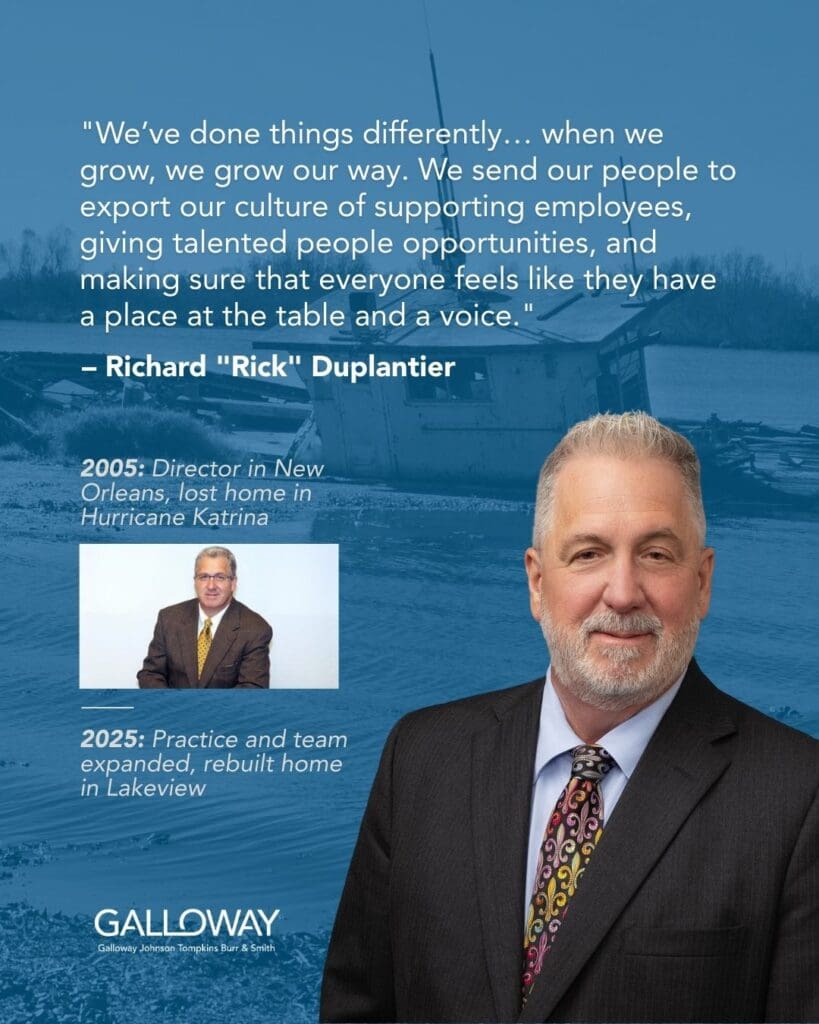
“We didn’t have a home, we didn’t have clothes, and yet we found a way to make do.” — Doris Bobadilla
Lasting Changes for Galloway
Katrina taught Galloway that they could spread their resources throughout the Gulf South. “Before that, everything was headquartered in New Orleans, and after that, I made a conscious effort to spread things out more. We’re in the cloud, our Chief of HR is in Pensacola. We really made an effort to spread the risk geographically.” Preparedness also improved with clearer procedures of communication, new policies and investing in technology. “It taught us how much you have to be on the cutting edge of technology if you’re going to survive.”
From his own experience as a young lawyer, Jason saw Stephen’s story as another example of the firm’s values. “Galloway has always been willing to invest in those who earn it. When I came to Galloway, I wanted to practice blue water maritime and we weren’t doing any of that. Galloway invested in me to help me develop that line of work because they believed I can do it and they trusted me. We’ve always had that attitude of putting our resources behind people. We become successful by taking risk and you mitigate risk by choosing really good people to back on the assessment that they’ll be successful. A firm that grows is a firm that is willing to invest in its people to grow, to go out, and to be successful. The key to our success is our willingness to hire good people and then to back them with the resources they need to be successful.”
